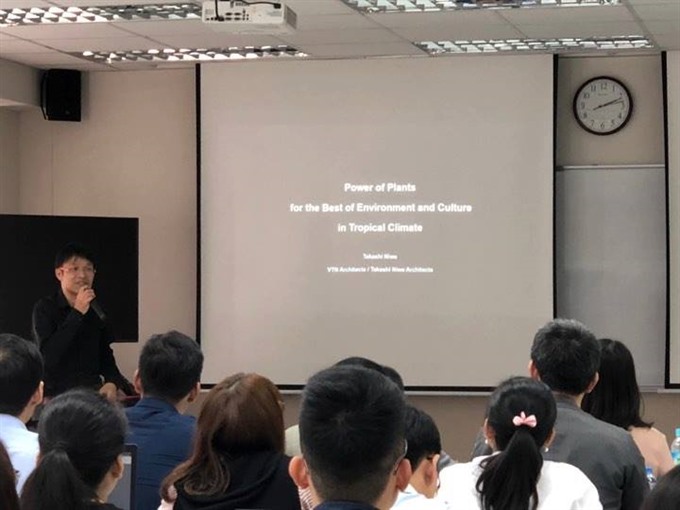 Expat Corner
Expat Corner

Nearly a decade ago, the uniqueness of Hà Nội’s culture and architecture drew Japanese architect Takashi Niwa to live and work here. Now, Niwa says he still feels there’s more to learn about the city as he seeks to develop designs inspired by Hà Nội.
 |
| Drawing board: Japanese architect Takashi Niwa is interested in projects relating to education and social responsibility. — Photo courtesy of the architect |
Trần Hoàng
Nearly a decade ago, the uniqueness of Hà Nội’s culture and architecture drew Japanese architect Takashi Niwa to live and work here. Now, Niwa says he still feels there’s more to learn about the city as he seeks to develop designs inspired by Hà Nội.
Niwa was born in
In 2010, he moved to Việt
Niwa met Nghĩa in
They decided to focus on two themes in their designs: green architecture and the use of bamboo.
Bamboo projects fit the traditions of Vietnamese culture. On remarkable example of architecture using this material is the Bamboo Wing Restaurant at Flamingo Đại Lải Resort in the
Green projects are also a unique style that brings many environmental benefits not only for the users but also for the city and neighbours. The duo’s Farming Kindergarten project in the southern province of Đồng Nai was very meaningful to Niwa.
“We tried to make it an experiential learning place for 500 children whose parents work at a shoe factory, using a sloping roof with gardens,” said Niwa.
“The project won many global prizes thanks to the good results.”
 |
| Next generation: Architect Niwa often hosts workshops with students in Việt Nam. — Photo courtesy of the architect |
Inspired by Hà Nội
For Niwa, Hà Nội is an interesting city with great potential for architecture.
“The traditional material, local culture, even the severe climate can contribute to making good architecture, which will bring many cultural values together with environmental benefits, including comfort,” he said.
“As a foreigner, I can see the valuable potential of Hà Nội to be more unique and original. I would really love to see Hà Nội in the future as a unique city, a combination of modernity and tradition.”
“During my eight years staying in Hà Nội, the city has changed a lot,” he said.
“One good thing is that people are planting more trees. The city has become cleaner though it is still messy.”
“Because the land price is too expensive, it is very difficult to maintain beneficial common open space in the city. The fast development has been breaking and eating up Hà Nội’s cityscape, which is one of the best tourist destinations to discover.”
The architect pointed out that there are many buildings with good potential to be rehabilitated and preserved to keep the town’s unique aesthetic. However, not many architects are able to make use of the potential because of the city’s inflexible preservation strategy, he said.
“Preservation is not only keeping the building itself,” said Niwa.
“Reusing old buildings to take advantages of their potential for facilities can create a very unique destination for people to enjoy and can also be good for tourism with good design. In this way, the owners can be sure to utilise and preserve the good conditions of the building, I think.”
“I’m really curious to create an example to show the usage of an old building in cooperation with the Government, owner and the other architects.”
 |
| Inspired by the city: Architect Niwa said he wants to learn more about the city and develop designs inspired by Hà Nội. — Photo courtesy of the architect |
Looking ahead
In 2018, Niwa started his own office, Takashi Niwa Architects in Hà Nội, to develop more projects with the theme “the best of environment and culture”.
Apart from professional work, Niwa participated in different projects relating to architecture in Việt
Recently, he hosted an exhibition titled “The Best of Environment and Culture” which listed eight elements of architectural design including Environment, Culture, Material, Energy, Emotion, Activity, Time and People.
Niwa is especially interested in school and educational projects.
“Through suitable designs for children, they are able to develop activities and discover the potential of their future life,” he said.
Some of his favourite projects in Việt
He co-operated with Japanese and Vietnamese colleagues to start a volunteer activity called